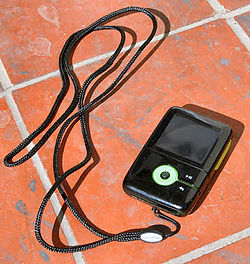 | |
| Manufacturer | Creative Technology |
|---|---|
| Product family | Creative Zen |
| Type | Digital audio player |
| Lifespan | 2006–2008 |
| Media | Available in 1, 2, 4, 8, 16 GB sizes |
| Operating system | ZEN UI |
| System on a chip | SigmaTel STMP3600 [1] |
| Display | 1.5-inch OLED display |
| Input | Multi-directional joystick, play and back buttons, power/hold switch, dedicated volume control buttons |
| Connectivity | USB 2.0 |
The ZEN V and the ZEN V Plus are portable media players manufactured by Creative Technology. The user interface on this player, the same as the one on Creative's ZEN Vision:M, was patented by Creative on January 9, 2005. [2] Creative sued Apple over the use of this user interface; Apple later settled for $100 million. [3]
They are very small sized and feature an OLED screen measuring 1.5 inches. It is controlled using a 5-way mini joystick. [4] The ZEN V Plus has accumulated many awards, including CNET Editor's Choice for June 2006. [5] The players are nearly identical save for video playback and FM radio, which the ZEN V Plus supports but the regular ZEN V does not.
In August 2007, Creative introduced a 16 GB version of the ZEN V Plus, making it the first flash-based player with that capacity. [6]